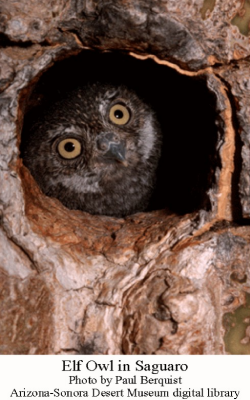
The Elf owl (Micrathene whitneyi) is our smallest owl. Its body size is about the same as a sparrow (5 to 6 inches), but its wingspan is larger (13 to 16 inches).
These owls occur in Southern Arizona, the boot-heel of New Mexico, the Big Bend area of Texas, and nearly all of Mexico including the southern tip of Baja. In the winter, Elf owls in the U.S. generally migrate to Mexico.
“The classic image of an Elf Owl looking out of a hole in a Saguaro cactus may be overemphasized. They are abundant in the Saguaro deserts but also are abundant into the mountains reaching elevations of up to about 6000 ft. They can be found in dense mesquite, dry oak woodlands, wooded canyons, sycamores, and probably any other tree within its elevation range. They may be seen in dense scrub and in woodpecker holes in cottonwoods or telephone poles. Classically they are in high desert, foothills, and low in the mountains, and often in dryer habitats.” Source
Elf owls eat spiders, scorpions, beetles, moths, grasshoppers, crickets and other insects. They generally hunt at dawn and dusk. They can catch prey in mid-air or pluck them off tree branches.
 Elf owls often nest in abandoned woodpecker holes in saguaro cactus and in natural cavities in upland trees such as sycamores, pines, and walnuts. “Males attract females to potential nest sites by calling from a cavity, then flying out while singing as she approaches. On moonlit nights calling occurs continuously all night. The female selects the nest cavity and begins to roost in it prior to laying eggs to prevent occupation by other hole-nesting birds.” Source “Breeding season in North America is normally May and June (March through August in Mexico). 1 – 5 eggs may be laid but 3 are most common. The incubation period is 21 – 24 days. The young can capture food as soon as they can fly (27-28 days of age) and fledge shortly thereafter (28 – 33 days of age).” Source
Elf owls often nest in abandoned woodpecker holes in saguaro cactus and in natural cavities in upland trees such as sycamores, pines, and walnuts. “Males attract females to potential nest sites by calling from a cavity, then flying out while singing as she approaches. On moonlit nights calling occurs continuously all night. The female selects the nest cavity and begins to roost in it prior to laying eggs to prevent occupation by other hole-nesting birds.” Source “Breeding season in North America is normally May and June (March through August in Mexico). 1 – 5 eggs may be laid but 3 are most common. The incubation period is 21 – 24 days. The young can capture food as soon as they can fly (27-28 days of age) and fledge shortly thereafter (28 – 33 days of age).” Source
The call consists of a variety of soft yelping notes, often running together into a high-pitched chatter. You can hear some sound recordings here.
According to the Arizona-Sonora Desert Museum:
“Elf Owls, like other owls have excellent night vision. They can’t see in complete darkness, but they can see quite well in low-light. They also have excellent hearing. They can catch their prey in complete darkness, by pinpointing it using their ears rather than eyes. Elf owls have “silent flight” which means they don’t make any noise as they approach their prey. The sound of their wing beat is muffled by softened feathers on the leading edges of their wings.” Source
Elf owls are preyed upon by other owls, snakes, coyotes, bobcats and ringtails. Their life span in the wild is 3-6 years. Starlings, which are an introduced bird from Europe, pose a threat to Elf Owls. They take over nest cavities already in use by the Elf Owls, or by other birds according to ASDM. ASDM also notes that in dangerous situations, Elf owls will play dead until all danger has passed.
See many photos here.
See more stories on owls:
Note to readers: I have constructed a linked index to more than 400 of my ADI articles. You can see it at: https://wryheat.wordpress.com/adi-index/
You can read my comprehensive, 28-page essay on climate change here: http://wp.me/P3SUNp-1bq
